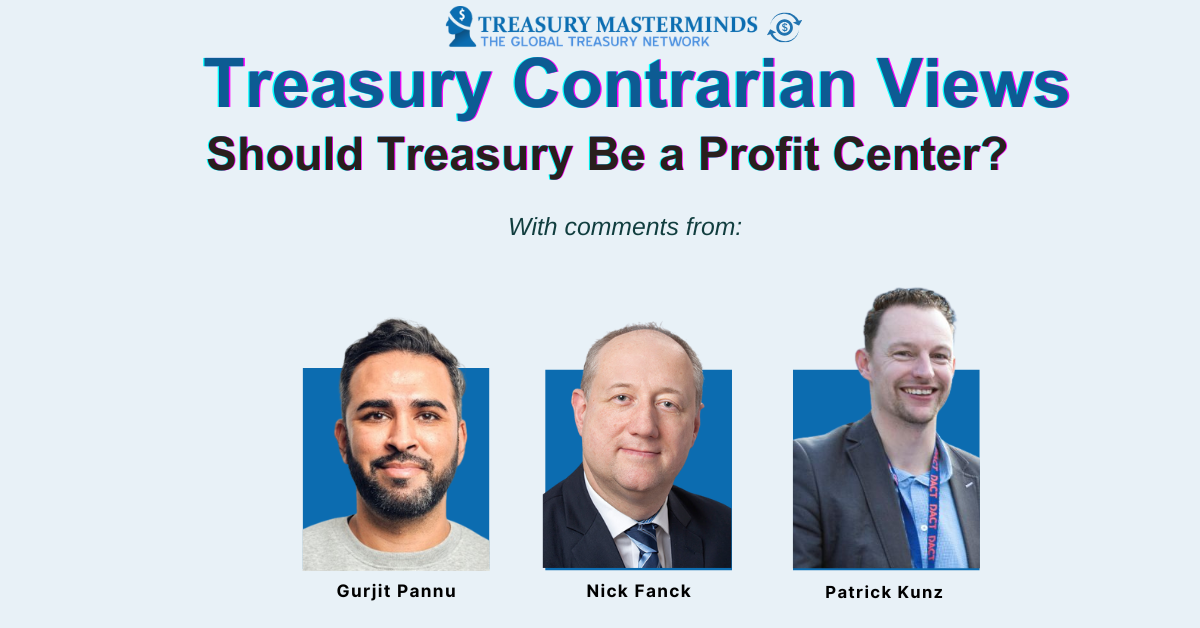
Traditionally, treasury has been seen as a cost center—a function focused on managing liquidity, risk, and financial operations rather than generating revenue. But as treasury teams gain access to more sophisticated tools, data, and financial instruments, a provocative question arises: Should treasury operate like a profit center rather than a cost center?
The Case for Treasury as a Profit Center
- Active Liquidity and Investment Management
- Treasurers can optimize excess liquidity by strategically investing in short-term instruments, money market funds, or yield-enhancing solutions rather than keeping cash idle.
- Foreign Exchange (FX) and Risk Management as a Value Driver
- Many treasury teams already manage FX exposures, but some argue that by proactively optimizing FX strategies, treasury can generate value rather than just mitigating risk.
- Supply Chain and Working Capital Optimization
- By leveraging supply chain finance programs, early payment discounts, or dynamic discounting, treasury can enhance working capital while also generating financial benefits.
- Banking and Financing Efficiencies
- Negotiating better banking terms, reducing transaction costs, and optimizing debt structures can drive direct financial savings, improving the company’s bottom line.
The Case Against Treasury as a Profit Center
- Treasury’s Core Function is Risk Management, Not Speculation
- Turning treasury into a profit center could encourage riskier behaviors, such as speculative trading or aggressive investment strategies that deviate from the company’s risk tolerance.
- Potential Conflicts of Interest
- If treasury is incentivized to generate profits, its objectives may conflict with core business priorities, such as liquidity preservation and cost-effective funding.
- Performance Measurement Challenges
- Unlike sales or investment divisions, treasury’s success is often measured by stability, efficiency, and cost reduction—metrics that don’t easily translate into profit-driven KPIs.
- Regulatory and Compliance Considerations
- Depending on the jurisdiction, engaging in profit-generating financial activities may expose treasury to additional regulations, taxes, and reporting complexities.
The Middle Ground: Treasury as a Value-Adding Function
Instead of classifying treasury strictly as a cost or profit center, companies can take a hybrid approach:
- Strategic Liquidity Management: Treasury can generate value through optimized cash deployment without taking unnecessary risks.
- Enhanced Cost Savings Initiatives: By reducing transaction costs, negotiating favorable financing terms, and improving efficiency, treasury can contribute to financial performance.
- Risk-Aware Revenue Opportunities: Treasury can explore yield-enhancing strategies that align with the company’s risk appetite and business objectives.
Let’s Discuss
- Should treasury be measured on its ability to generate profit, or should it remain focused on risk management and operational efficiency?
- Has your company explored treasury-led value creation initiatives? If so, what were the results?
- What risks or challenges do you see in shifting treasury toward a profit-generating mindset?
We’ll be sharing insights from treasury leaders and industry experts—join the conversation and share your perspective!
COMMENTS:

Gurjit Pannu, Co-Founder/Co-CEO at Palm, comments:
- Keep Funds (and Liquidity) Safe First: Safety is paramount. The core responsibilities around liquidity, cash preservation, and managing risk must remain the top priorities. Without a secure base, ventures into profit-oriented strategies can become speculative gambles.
- Rationalize Costs as a Baseline: Treasury can help flip from being a traditional “cost center” to an emerging “value center” by consistently bringing down the cost base. This could include:
- Negotiating lower banking fees
- Auctioning FX trades
- Optimizing payment rails to reduce transaction expense.
These efficiencies both generate immediate savings and free up capital for strategic initiatives.
- Explore Controlled Profit Opportunities: Once the house is in order, the treasury team has a platform to explore incremental revenue-generation, such as yield-enhancing investment strategies that stay within the company’s risk tolerance.
Teams can also get creative without opening up too much risk. Depending on the company’s line of business, there may also be opportunities in partnering with financial institutions to create new business models.
During my time at Uber, for instance, we explored partnerships with our banking partners to help new drivers (many without bank accounts) open retail banking services, sharing in resulting profits. This non-traditional approach aligned with the company’s operational needs while opening a fresh revenue stream. - Balance Risk with Returns: Treasury should never lose sight of its core mission. Any venture into profit generation must align with established risk parameters. “Safe first, profitable second” ensures that treasury’s revenue-based initiatives don’t compromise liquidity or create unforeseen exposures.
In the end, viewing the treasury as a potential profit center does not mean abandoning its foundational responsibilities. Instead, it means leveraging the treasury’s unique position—access to company-wide cash flows, market insights, and strategic relationships—to both safeguard the firm’s financial health and, where appropriate, capture additional value.

Nick Franck, Treasury Masterminds board member, comments:
I agree completely, but suggest the terminology gets in the way.
A) A basic treasury does cash management
B) A more advanced treasury does liquidity management and passive risk management, including hedging
This, when done well, handles the known-unknowns. What about the unknown-unknowns? Non-treasury created situations that are existential risks.
80% of companies go out of business because they become insolvent. That makes it a treasury matter.
What does a company need to handle unknown-unknowns?
👉 Experts in the financing and the financial markets
👉 People, systems and processes that enable real-time control as well as support of the experts in whatever they do
👉 Policies that allow the people above to do their work flexibly, in real-time – ie, without CFO approval for every significant action
👉 Management who understand the above and set strategies and policies to enable the above
Unknown-unknown crises don’t happen all the time. How can senior management know whether the treasury function is fit for purpose and can react well in real time.
💡 Make them manage real-time changing markets
➡ If they don’t make profits, they’re not fit for purpose
‘Profit-centre’ treasuries are also ‘Better controlled’ treasuries

Patrick Kunz, Treasury Masterminds Founder/board member, comments:
Profit center is too strong of a statement imho. That would imply risk taking and profit as a goal. Treasury goal is preservation of cash and minimisation of risk but only treating that as a cost center is too weak as well. Cost minimisation is easy and the basic thing to do as a treasurer. A great treasurer vs a basic treasurer treats his treasury as a company. Leveraging opportunities for new investments (while keeping risk the same), finding ways to optimise payment flows, new financing counterparties, just to name a few things to do.
Be an “entrepreneur” inside the company. You are the guardian of the cash and the protector but also like to keep the treasury full for as long as possible. In practise this means the treasurer has to collaborate internal to drive improvements, to increase risk awareness or to get better data quality. Be an ambassador for the treasury department inside the company and create awareness about cash (is king). That is where the “profit” starts.
Also Read
- Treasury Contrarian View: The Case Against In-House Banks
- Treasury Contrarian View: ESG in Treasury—A Passing Trend or the Future?
- Treasury Contrarian View: Do We Really Need Treasury Centers in Every Region?
- Understanding Bank Treasury: Managing Liquidity, Risk, and Regulatory Compliance
- Treasury Contrarian View: AI in Treasury—Hype or Reality?
- Trends Transforming the Current Treasury Management System (TMS) Landscape
- Treasury Contrarian View: Are Treasury Certifications Still Worth It?
- Treasury Contrarian View: Treasury Without Borders—Should Treasury Teams Go 100% Remote?
- Treasury Contrarian View: Why Stop at 100% Hedging?
- Treasury Contrarian View: Banks vs. Fintechs – Should Treasurers Bet on Smaller Players?
Join our Treasury Community
Treasury Mastermind is a community of professionals working in treasury management or those interested in learning more about various topics related to treasury management, including cash management, foreign exchange management, and payments. To register and connect with Treasury professionals, click [HERE] or fill out the form below to get more information.